3 September 2025
When to Pause Amazon PPC Campaigns: A Data-Driven Guide
TweetLinkedInShareEmailPrint Amazon Pay-Per-Click (PPC) is the engine of growth for most sellers, but it can ...
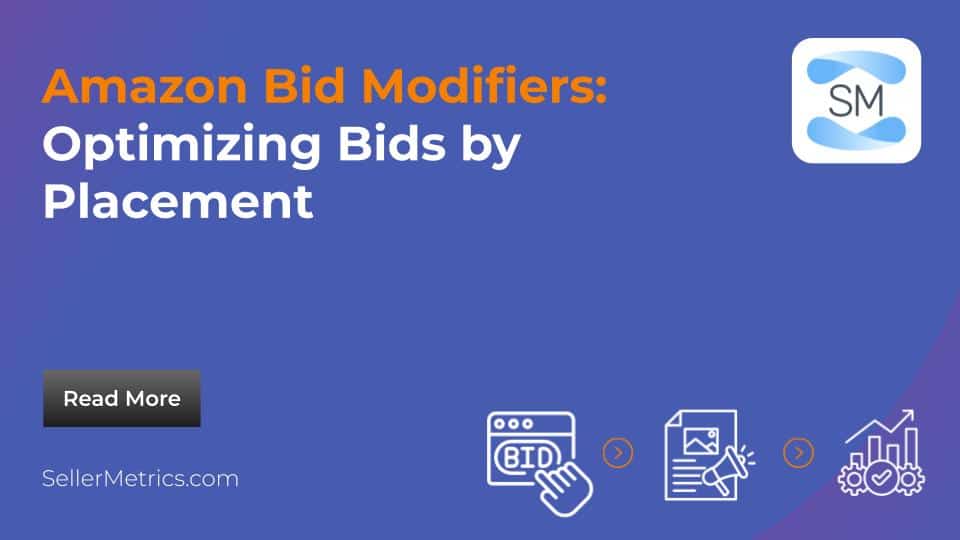
If you’ve ever wondered how to get your Amazon ads in front of more buyers without blowing your budget, you’re not alone.
As an Amazon seller, staying competitive means mastering Amazon Advertising. One of the most powerful tools at your disposal is bid placement modifiers. Understanding and optimizing Amazon Ads Placement Modifiers allows you to strategically adjust bids based on where your ads appear, significantly improving ad performance and maximizing ROI.
Let’s break down how to use bid modifiers without the guesswork. This detailed guide dives deep into Amazon bid modifiers, highlighting best practices, strategies, and practical tips to empower you to make informed advertising decisions.
Article Contents
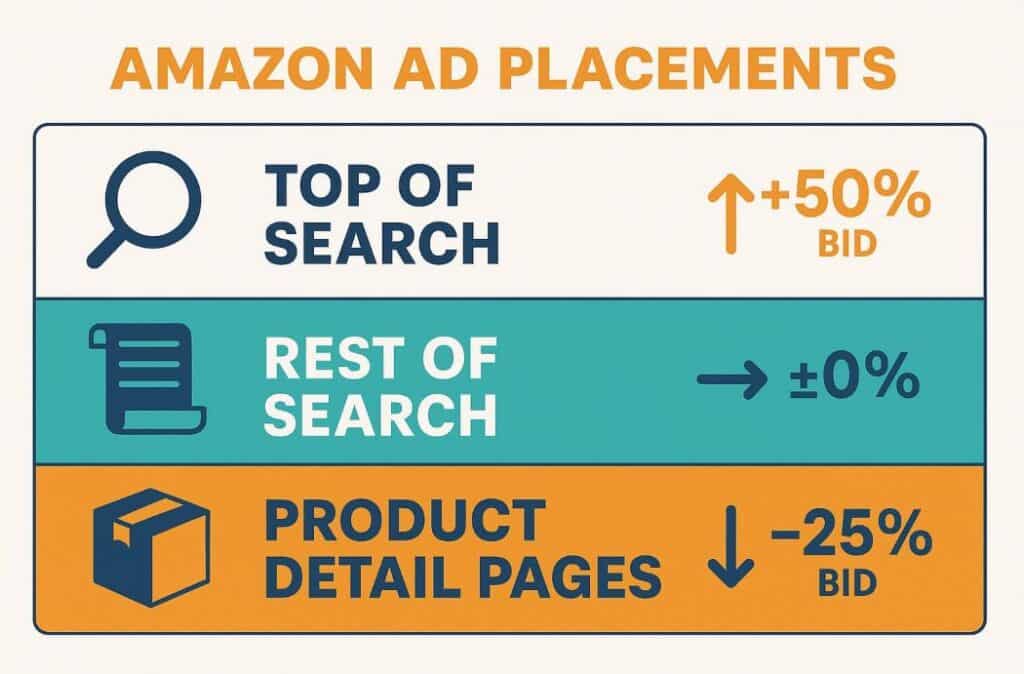
Amazon bid modifiers are percentage adjustments you can apply to your existing bids to increase or decrease the likelihood of your ads appearing in specific placements. Amazon provides three primary placements for ads:
Think of it like giving your best-performing placements a little boost, and holding back on those that don’t convert. By adjusting bids based on these placements, you can direct your advertising budget to where it matters most—high-visibility locations with the greatest potential for conversion.
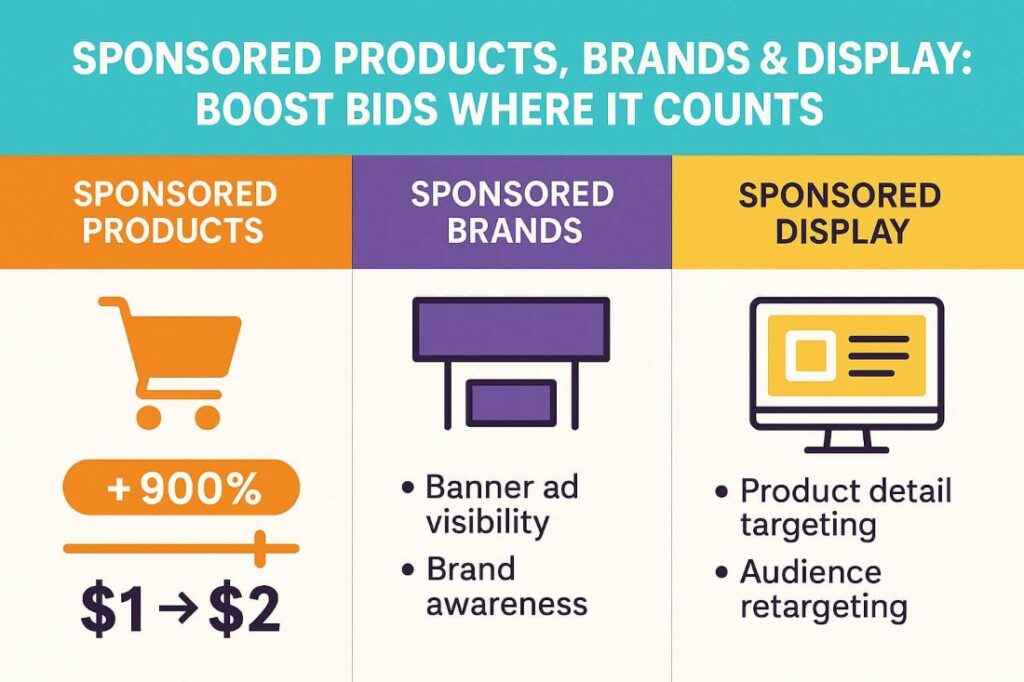
Sponsored Products campaigns are typically keyword-driven and allow placement adjustments at the campaign level. Amazon lets you boost your bids by up to 900% for either Top of Search or Product Detail Pages, depending on performance. It’s like putting your foot on the gas when the traffic is worth it.
For instance, if your default bid is $1 and you apply a 100% modifier for Top of Search, your effective bid for that placement becomes $2. Sponsored Products provides granular control, enabling precision targeting based on your historical performance data.
Unlike Sponsored Products, Sponsored Brands offer less granular control over placements. However, you can still optimize bids during campaign creation to prioritize visibility for specific placements like headline banners or product collection ads.
Typically, Sponsored Brands are used to increase brand visibility and awareness rather than direct conversion, so strategic adjustments here can enhance overall brand impact. Great for boosting brand presence, even if it’s not always about the click.
Sponsored Display campaigns focus on contextual and audience-based targeting. Placement modifiers help you prioritize specific locations, such as product pages, which are ideal for retargeting visitors or capturing competitor traffic. Effective use of bid modifiers in Sponsored Display can dramatically improve engagement and conversion rates. These placements are perfect for staying top-of-mind.
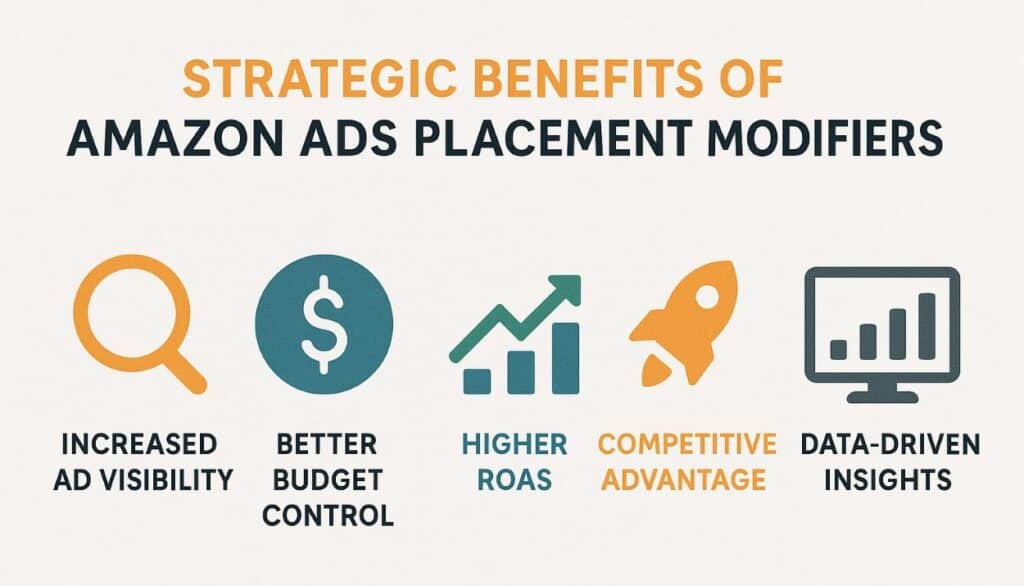
Understanding and utilizing Amazon Ads Placement Modifiers effectively is crucial for sellers aiming to maximize returns from their Amazon advertising spend. Placement bid modifiers offer granular control over your ad strategy, enabling you to precisely target where your ads appear on Amazon’s search results and product detail pages. By mastering these tools, you unlock several substantial advantages that can dramatically impact your overall campaign success.
Not all clicks are created equal, and placement modifiers help you chase the ones that count. One of the primary benefits of leveraging Amazon bid modifiers is gaining increased visibility in the placements where customers are most likely to click and convert.
Similarly, not all ad placements perform equally. Some locations consistently generate better engagement and higher conversion rates. Top-of-search placements, for example, typically offer substantially higher click-through rates (CTR) and conversion rates (CVR) due to their prominent positioning.
Bid modifiers empower sellers to strategically allocate budget towards these high-performing placements. By increasing your bids specifically for top-of-search placements, you effectively prioritize your ads, giving them maximum exposure exactly where customers exhibit strong buying intent. As a result, you capture more valuable clicks and drive higher-quality traffic directly to your listings, ultimately increasing your sales and profitability.
Amazon advertising can quickly become costly without careful budget management. Fortunately, placement bid modifiers enable you to direct your budget to placements with proven historical success, thereby significantly improving your advertising efficiency. Rather than spreading your budget evenly or indiscriminately, bid modifiers enable you to channel resources precisely into placements that have demonstrated favorable returns. It’s like giving your budget a compass—it knows exactly where to go.
Additionally, you can identify and reduce spending in lower-performing ad placements. For instance, if product detail page placements show consistently poor conversions for certain products or keywords, decreasing your bids for these placements conserves your budget, freeing up resources for placements with superior performance. This level of control helps you prevent wasted spend, optimize your overall Advertising Cost of Sales (ACoS), and achieve a more profitable ad strategy.
Leveraging Amazon Ads Placement Modifiers directly enhances your campaign’s return on ad spend (ROAS). By allocating more budget to placements with the highest conversion likelihood, you optimize the profitability of every advertising dollar invested. Sellers who strategically manage placement modifiers regularly report improved ROAS, demonstrating a clearer path to achieving sustainable profitability from their Amazon advertising campaigns.
Moreover, placement modifiers give you the ability to respond dynamically to changing market conditions and competition levels. As competition fluctuates—whether due to seasonal demand shifts or new market entrants—you can quickly adjust your bids to maintain optimal visibility without overspending. This flexibility helps preserve and enhance your competitive advantage, further amplifying your overall returns. No one wants to spend more and get less. Modifiers help avoid that trap.
Many Amazon sellers still underutilize or misunderstand the power of placement modifiers. Consequently, sellers who leverage these bid adjustments effectively gain a distinct competitive edge. By consistently appearing in high-value placements, your products gain critical visibility, brand recognition, and market share over competitors who fail to optimize their bid placement strategies.
For example, if a competing seller neglects to apply modifiers effectively, their ads might consistently appear in suboptimal placements, reducing their visibility and conversion potential. By contrast, your strategic use of bid modifiers ensures your products dominate prime ad real estate, helping your brand stand out prominently on the platform and compelling more customers to choose your offerings over competitors’.
Finally, one of the often-overlooked benefits of regularly using Amazon bid modifiers is the rich insight you gain into customer behavior, placement performance, and ad effectiveness. Regularly analyzing placement reports and bid modifier impacts provides essential data points that inform your broader Amazon advertising strategy.
Over time, this knowledge helps you refine targeting strategies, optimize your keyword choices, and identify new opportunities to scale your advertising campaigns effectively. You become more adept at recognizing customer trends, responding to market dynamics, and proactively adjusting your advertising approach to consistently stay ahead.

Optimizing your Amazon ads isn’t just about identifying the best keywords or crafting compelling creative; it’s also about strategically managing your placement bids, especially for Product Detail Page (PDP) placements. Knowing precisely when to increase or decrease your bids for ads appearing on product detail pages can make the difference between significant advertising returns and unnecessary expenditure.
Product Detail Pages represent a unique placement because potential customers viewing these pages have typically demonstrated clear purchasing intent. Leveraging this intent effectively can result in high conversion rates, making PDP ads particularly attractive in specific scenarios.
1. Competitor Conquesting:
One of the most effective times to increase your bids for PDP placements is when executing competitor conquesting strategies. If your goal is to capture market share from established competitors, positioning your products prominently on their product detail pages can redirect high-intent traffic toward your offerings. In these scenarios, shoppers are actively comparing products, and a strategically placed ad can significantly influence their purchasing decision.
For instance, if you sell a highly rated kitchen gadget that competes directly with a popular product, increasing bids on that competitor’s PDP ensures your product is prominently displayed right when customers are considering their options. You’re not just showing up—you’re showing up right on your rival’s turf.
Although this tactic tends to have slightly lower click-through rates (CTR) than top-of-search placements, conversion rates (CVR) can be notably higher since visitors are already in the final stages of their buying journey.
2. Retargeting Past Visitors:
Increasing PDP bids can also be highly effective when retargeting users who’ve interacted with your product listings previously. Customers who’ve visited your products or similar items are prime targets for PDP ads, as they may simply need an additional reminder or a slight push to complete their purchase. Slightly elevated bids ensure your ads remain highly visible to these warm leads, significantly increasing the likelihood they’ll revisit and convert.
3. New Product Variations or Bundles:
When launching new product variations or bundles, increasing your bids on related PDP placements can help existing customers or interested shoppers discover your newest offerings. For example, promoting a bundled set of complementary products on the PDPs of individual items can effectively upsell or cross-sell, driving a higher average order value (AOV). Think of it as giving your newest offerings a stage to shine.
Just as increasing your PDP placement bids can be beneficial, there are equally compelling reasons to strategically decrease bids to avoid wasting valuable advertising dollars.
1. Consistently Low Conversion Rates:
If you’ve consistently observed low conversion rates from your PDP placements despite sufficient impressions and clicks, it’s time to reduce bids. Product detail pages can sometimes generate a high volume of traffic with minimal conversion, particularly if visitors are casually browsing rather than actively purchasing.
If the traffic’s not buying, there’s no point paying a premium. By carefully analyzing your placement reports in Amazon’s advertising console, you can identify underperforming PDP placements and reduce your bids accordingly. Redirecting these funds toward higher-converting placements, such as top-of-search ads, can boost overall profitability.
2. Excessive Advertising Cost of Sale (ACoS):
If your ACoS is consistently too high on PDP placements, it’s a clear signal that your current bids are not delivering sustainable returns. Even if conversions do occur, excessively high ACoS can diminish profitability. Adjusting your bids downward allows you to better balance visibility with profitability, helping you maintain healthy margins without completely abandoning this ad placement.
3. Seasonal or Product Lifecycle Considerations:
Product Detail Page ad performance may fluctuate significantly based on seasonal trends or the lifecycle stage of your products. For products nearing the end of their lifecycle or during off-peak sales periods, it’s prudent to reduce PDP bids. By being responsive to these seasonal shifts and product lifecycles, you maintain a lean advertising budget, preserving funds for periods of peak demand or for newer, higher-margin products.
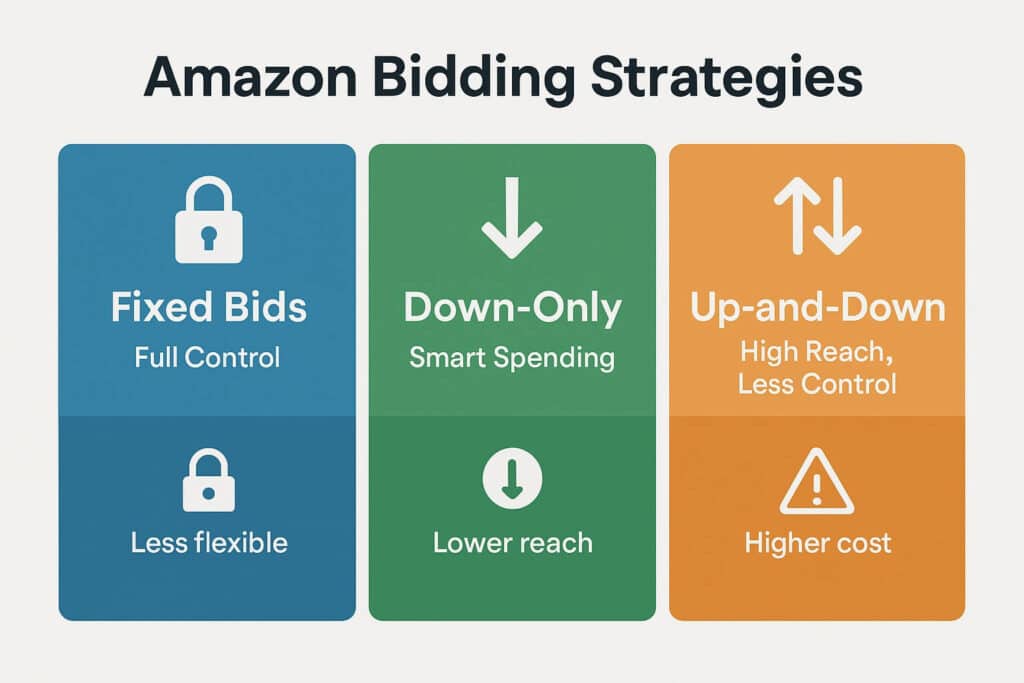
Amazon offers three bidding strategies:
Choosing the right bid strategy can mean the difference between controlled spending and runaway costs. Pairing dynamic bids with placement modifiers requires a nuanced understanding of your product performance and campaign goals. Typically, Down-Only bidding, combined with strategic placement adjustments, yields consistent and profitable outcomes.

To effectively leverage Amazon Ads Placement Modifiers, it’s critical to understand how performance varies significantly by ad placement. Metrics like Click-Through Rate (CTR) and Conversion Rate (CVR) differ considerably depending on whether your ads appear at the Top of Search, Rest of Search, or Product Detail Pages. Leveraging this understanding allows you to strategically allocate your budget, maximize returns, and achieve greater control over your Amazon advertising strategy.
The Top of Search placement is coveted real estate within Amazon’s advertising ecosystem. Ads placed here appear prominently at the top of the first page of search results, providing unparalleled visibility. Due to their prominent positioning, these ads consistently achieve the highest performance metrics across Amazon placements.
On average, Top of Search ads see CTRs ranging between 5% and 12%, significantly outperforming other placements. In competitive categories or during high-demand periods (such as Prime Day or the holiday season), CTR can even exceed 15%. The clear visibility, coupled with high buyer intent, means consumers are more likely to click and explore your products further.
Conversion Rates for Top of Search ads are equally impressive. Typically, these ads yield a CVR in the range of 10% to 20%, depending on product category and relevance. Because shoppers using specific keywords are often in the later stages of the buying journey, the chances of converting clicks into sales at this placement are remarkably high.
In short, this is prime real estate—buyers are actively searching and ready to click. Investing more aggressively in Top of Search ads through bid modifiers can directly drive sales, lower Advertising Cost of Sales (ACoS), and deliver substantial profitability.
Product Detail Page ads occupy space on individual product listings, frequently appearing as recommendations related to items shoppers are already viewing. Due to the nature of this placement, where customers have shown specific product-level interest, these ads often have notably lower CTRs but can still perform well in terms of conversions.
Average CTR for Product Detail Page placements typically ranges from 0.3% to 1%, significantly lower than Top of Search ads. The reason is straightforward: shoppers are usually more focused on evaluating the product they originally clicked, rather than actively searching for alternatives. Despite this lower CTR, PDP placements can be particularly valuable if your ads are highly relevant and competitively positioned.
When ads on PDP placements are strategically targeted (such as competitor conquesting or retargeting scenarios), the CVR can still be strong, averaging between 5% and 10%. Customers browsing Product Detail Pages often have a higher-than-average intent to purchase, especially if your ad features a compelling product alternative, competitive price, or favorable customer reviews.
Consequently, despite fewer clicks, the overall profitability of PDP placements can be surprisingly robust, making selective bidding in this placement worthwhile.
Ads that appear in the Rest of Search placement represent the majority of ad inventory across Amazon’s search result pages beyond the prominent Top of Search section. These placements offer broader coverage across multiple pages of search results, capturing shoppers who are still in the exploratory phase of their purchase journey.
Rest of Search placements typically yield moderate CTRs, averaging between 1% and 4%. These ads attract shoppers who scroll beyond the first few results, typically indicating less immediate purchasing intent or buyers who are researching and comparing options. Therefore, CTR tends to be lower compared to Top of Search ads.
Similarly, conversion rates in this placement generally range from 3% to 8%. While this is lower than Top of Search, Rest of Search ads benefit from considerably lower Cost-per-Click (CPC), providing cost-effective exposure that balances out the comparatively lower CVR.
Rest of Search placements are ideal for sustaining steady brand visibility across multiple keywords or broader product categories at a manageable cost, making them especially valuable in scenarios where budget constraints are present or where brand awareness is the primary objective.
The key takeaway from analyzing these placement-based CTR and CVR benchmarks is clear: strategically aligning your bid modifiers to reflect placement performance is critical to maximizing Amazon advertising effectiveness.
For instance, campaigns targeting high-intent, competitive keywords should prioritize higher modifiers for Top of Search placements to capitalize on strong conversion potential. Conversely, if your objective is maintaining long-term brand visibility or cost-efficient exposure, moderate bids on Rest of Search placements can help balance your advertising budget without sacrificing significant visibility.
Regularly analyzing your Amazon Advertising placement reports provides real-time insights into how your campaigns perform compared to these benchmarks. Tracking metrics such as impressions, clicks, conversions, and ACoS helps you refine your bid strategies continuously. Incremental adjustments, backed by consistent data monitoring, enable you to optimize ad spend, minimize wasted budget, and enhance overall campaign profitability.
Data isn’t just numbers—it’s your roadmap to better performance.
Optimizing bids using Amazon Ads Placement Modifiers significantly enhances your advertising strategy by increasing visibility, improving conversions, and managing budgets efficiently. Use the available data, regularly analyze placement performance, and strategically adjust your modifiers to achieve maximum returns. If you want your ad dollars to do more, this is where you start.
You can increase bids by up to 900% on Amazon.
Use the Amazon Advertising dashboard placement reports to review performance.
Evaluate every 2–4 weeks, adjusting based on gathered performance data.
Yes, combining dynamic bidding strategies with modifiers is common practice.
No, modifiers apply only to manual Sponsored Product campaigns.
Top of Search placements are highly effective for new launches due to higher visibility.
If CPC dramatically increases without an improved conversion rate, it may be time to lower your modifier.